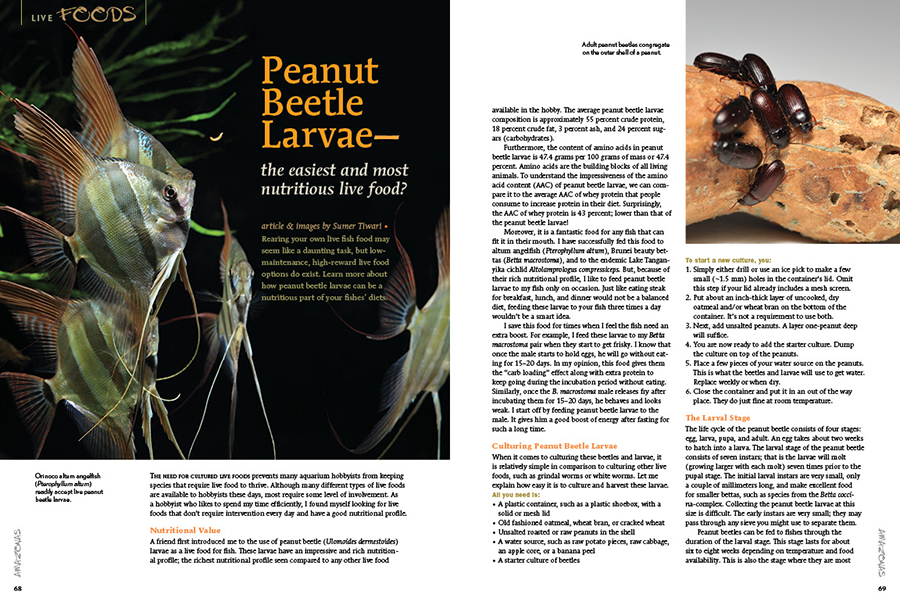
article and images by Sumer Tiwari
The need for cultured live foods prevents many aquarium hobbyists from keeping species that require live food to thrive. Although many different types of live foods are available to hobbyists these days, most require some level of involvement. As a hobbyist who likes to spend my time efficiently, I found myself looking for live foods that don’t require intervention every day and have a good nutritional profile.
BONUS VIDEO – Watch Tiwari’s Orinico altum angelfish devouring peanut beetle larvae
Nutritional Value
A friend first introduced me to the use of peanut beetle (Ulomoides dermestoides) larvae as a live food for fish. These larvae have an impressive and rich nutritional profile; the richest nutritional profile seen compared to any other live food available in the hobby. The average peanut beetle larvae composition is approximately 55 percent crude protein, 18 percent crude fat, 3 percent ash, and 24 percent sugars (carbohydrates).
Furthermore, the content of amino acids in peanut beetle larvae is 47.4 grams per 100 grams of mass or 47.4 percent. Amino acids are the building blocks of all living animals. To understand the impressiveness of the amino acid content (AAC) of peanut beetle larvae, we can compare it to the average AAC of whey protein that people consume to increase protein in their diet. Surprisingly, the AAC of whey protein is 43 percent; lower than that of the peanut beetle larvae!
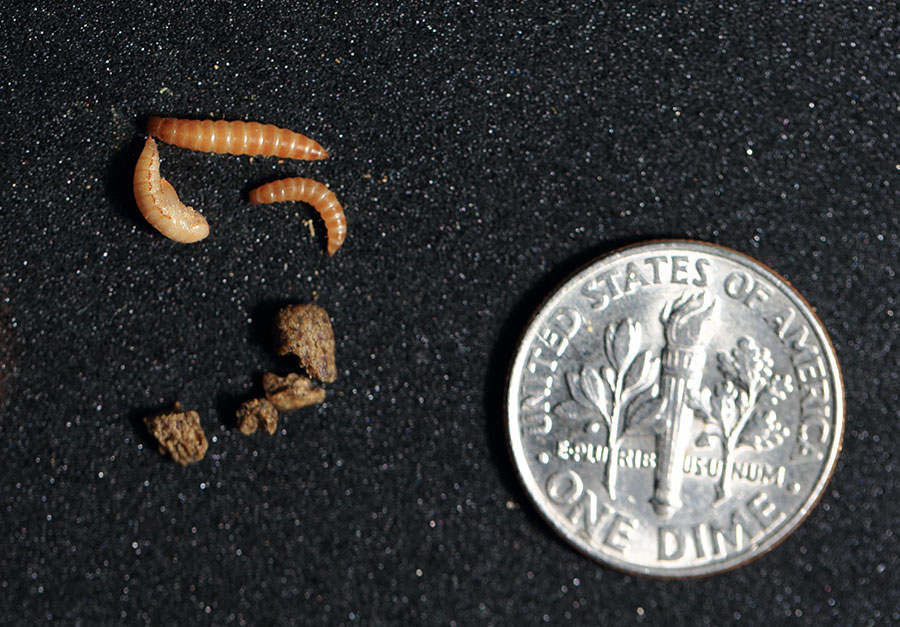
Moreover, it is a fantastic food for any fish that can fit it in their mouth. I have successfully fed this food to altum angelfish (Pterophyllum altum), Brunei beauty bettas (Betta macrostoma), and to the endemic Lake Tanganyika cichlid Altolamprologus compressiceps. But, because of their rich nutritional profile, I like to feed peanut beetle larvae to my fish only on occasion. Just like eating steak for breakfast, lunch, and dinner would not be a balanced diet, feeding these larvae to your fish three times a day wouldn’t be a smart idea.
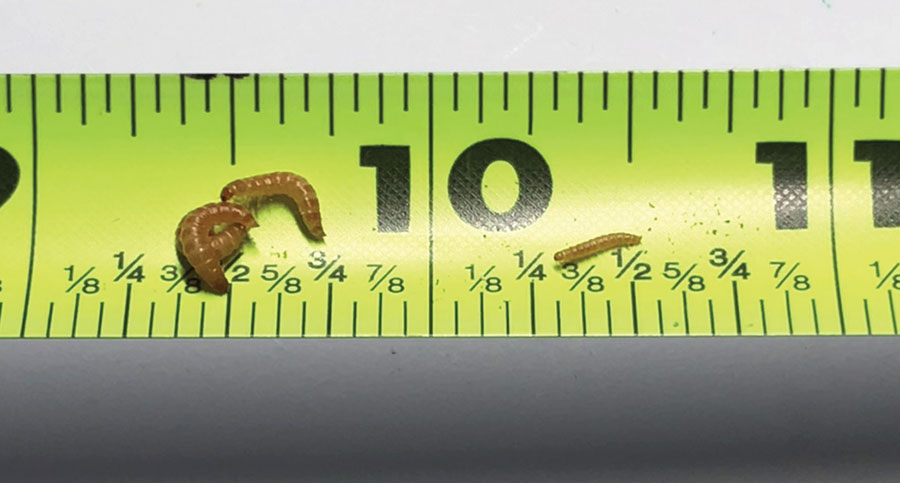
I save this food for times when I feel the fish need an extra boost. For example, I feed these larvae to my Betta macrostoma pair when they start to get frisky. I know that once the male starts to hold eggs, he will go without eating for 15–20 days. In my opinion, this food gives them the “carb loading” effect along with extra protein to keep going during the incubation period without eating. Similarly, once the B. macrostoma male releases fry after incubating them for 15–20 days, he behaves and looks weak. I start off by feeding peanut beetle larvae to the male. It gives him a good boost of energy after fasting for such a long time.
Culturing Peanut Beetle Larvae
When it comes to culturing these beetles and larvae, it is relatively simple in comparison to culturing other live foods, such as grindal worms or white worms. Let me explain how easy it is to culture and harvest these larvae.
All you need is:
- A plastic container, such as a plastic shoebox, with a solid or mesh lid
- Old fashioned oatmeal, wheat bran, or cracked wheat
- Unsalted roasted or raw peanuts in the shell
- A water source, such as raw potato pieces, raw cabbage, an apple core, or a banana peel
- A starter culture of beetles
To start a new culture, you:
- Simply either drill or use an ice pick to make a few small (~1.5 mm) holes in the container’s lid. Omit this step if your lid already includes a mesh screen.
- Put about an inch-thick layer of uncooked, dry oatmeal and/or wheat bran on the bottom of the container. It’s not a requirement to use both.
- Next, add unsalted peanuts. A layer one-peanut deep will suffice.
- You are now ready to add the starter culture. Dump the culture on top of the peanuts.
- Place a few pieces of your water source on the peanuts. This is what the beetles and larvae will use to get water. Replace weekly or when dry.
- Close the container and put it in an out of the way place. They do just fine at room temperature.
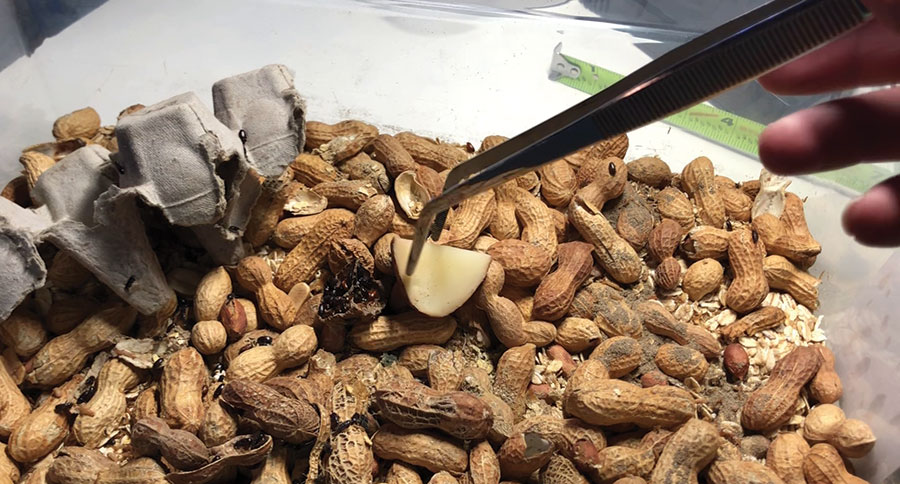
The Larval Stage
The life cycle of the peanut beetle consists of four stages: egg, larva, pupa, and adult. An egg takes about two weeks to hatch into a larva. The larval stage of the peanut beetle consists of seven instars; that is the larvae will molt (growing larger with each molt) seven times prior to the pupal stage. The initial larval instars are very small, only a couple of millimeters long, and make excellent food for smaller bettas, such as species from the Betta coccina-complex. Collecting the peanut beetle larvae at this size is difficult. The early instars are very small; they may pass through any sieve you might use to separate them.
Peanut beetles can be fed to fishes through the duration of the larval stage. This stage lasts for about six to eight weeks depending on temperature and food availability. This is also the stage where they are most nutritious. Since larvae consume a lot as they continue to molt, they usually stay inside a peanut eating it. The best way to harvest them is to look for a peanut full of larvae. Once you have found one, it is very easy to shake them out into a separate container. I usually go through a few peanuts with forceps until I see one that is full of larvae. One such peanut usually contains a good combination of various sized larvae. Many late instar larvae dig into the substrate to enter the pupal stage. If you can’t find a peanut full of larvae, just go through the substrate and pick larvae using a pair of forceps as you see them.
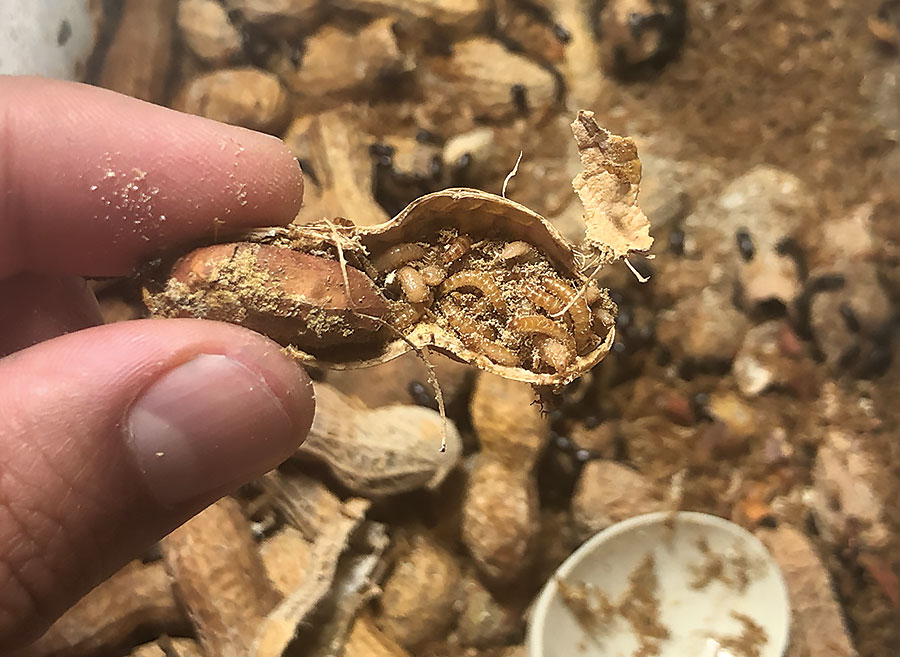
BONUS VIDEO: A look at harvesting peanut beetle larvae for feeding
The Pupal Stage into Adulthood
Commencement of the pupal stage means that the beetle has started the process of building its defense mechanism. They definitely have a pretty hard cocoon. From my personal experience, cichlids, such as altum angels, don’t really show a preference between larvae and pupae as they will eat whatever fits in their mouth. That being said, we know that once the pupal stage has started, the pupa has no means of consuming any kind of food. At that point, it is using the energy that it had gained in the larval stage to complete its metamorphosis into an adult beetle. I have not seen the nutritional value breakdown of a pupa, but I would assume that it’s lower than a larva or even an adult beetle. With that understanding, I don’t see value in feeding pupae to my fish.
A pupa will transform into an adult beetle in about a week. Adults can live for a very long time—about two years. During their lifetime, they continue to produce eggs. Adult peanut beetles exhibit sexual dimorphism, meaning that males and females have different physical characteristics. However, I don’t think these differences are noticeable by the naked human eye. Scientists typically use microscopes to study the anatomy of beetles (order Coleoptera) and have determined that the major morphological differences between the sexes lie in the size and form of sensilla (sensory receptors), hind legs, and body size.
Personal Experiences
I have realized that it is very easy to overlook the larvae, and adult beetles can overcrowd your culture if you don’t harvest larvae regularly. If you think about it, it’s not a bad thing as it tells us that they are easy to rear; even when left unattended.
They can survive on peanuts and a water source alone. When it comes to providing them with a source of water, you can get as involved as much as you want to. I have heard of hobbyists that like to offer apple, but I have found that apple attracts fungus very fast. Within two days, you would see mold and fungus growing on apple. Potato, however, doesn’t promote mold or fungal growth. Therefore, I usually use potato pieces for the water source. Admittedly, I have forgotten to add fresh pieces of potato on certain weeks in the past, and I could not see any difference in the population. This is also because the peanut kernel does contain water. We also need to remember that these insects are agricultural pests. When they live out there in the “real world”, they don’t have access to potatoes for water; they survive in peanut holding facilities on nothing but peanuts.
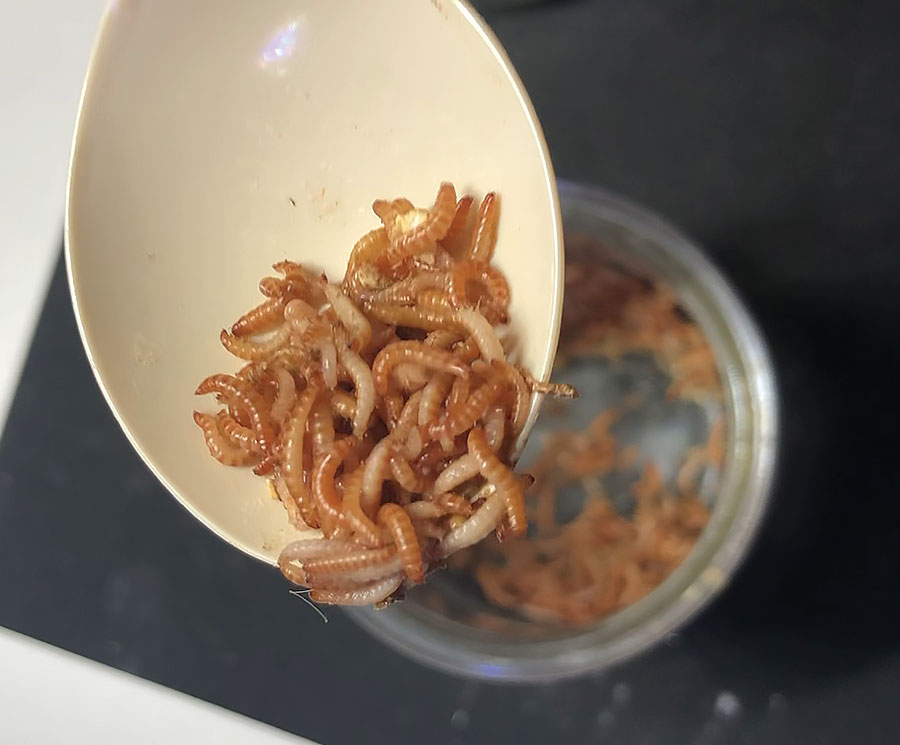
The culture I started off with continued to provide me with about 50–60 larvae every third or fourth day. If you feel like you need more than this amount, try maintaining two cultures. I ran my first culture for five months before I felt the need to start a new one. After five months, I could see that the layer of oatmeal and wheat bran had converted into frass, which appears as a dust-like debris. This simply means that the beetles and larvae have consumed the oatmeal and wheat bran. At this stage, I add more oatmeal and wheat bran to the existing culture, and I also start a brand-new culture by taking some beetles, larvae, pupae, and frass/media mix which contains the eggs. Both the cultures continue to produce a sizeable number of larvae. Ultimately, when it comes time to dispose of an old culture, place everything in a bag and freeze it for at least 24 hours to kill any eggs and larvae.
These critters are very easy to ship as well. When sharing a culture with someone, I make sure that I include each stage: larvae, pupae, and adult beetle. I also add some frass/media mix in the hopes that some eggs will also be present. Having a culture with animals in each stage of life helps get the new culture up and producing faster than starting with just adult beetles, for example. When shipping a culture, I include in the package a piece of egg carton for the beetle adults and larvae to hold on to, which makes the journey easier.
Human Consumption
While doing research on these beetles, I also learned that people in many cultures, especially Eastern cultures, consume these beetles as a supposed cure against various diseases such as cancer, asthma, lower back pain, and even Alzheimer’s disease. In the early 2000s, when immigrants brought these beetles to South American countries such as Brazil and Argentina, many researchers tried to find out if there was any proof behind these medical claims.
These beetles contain many chemicals that are capable of killing cells—good and bad equally. They also contain some chemicals that might act as an anti-irritant. However, the beetles also contain toxic benzoquinone compounds that are used in their defense mechanism. These chemical compounds may cause harm when ingested. Bottom line—don’t eat these beetles, but do feed the larvae to your fish!
References
Crespoa, R., et al. (2011). Cytotoxic and genotoxic effects of defence secretion of Ulomoides dermestoides on A549 cells. Journal of Ethnopharmacology, 136 (1), 204–209.
https://www.researchgate.net/profile/Rosana_Crespo/publication/51105256_Cytotoxic_and_genotoxic_effects_of_defence_secretion_of_Ulomoides_dermestoides_on_A549_cells/links/5a8ea7130f7e9b2fac8384b6/Cytotoxic-and-genotoxic-effects-of-defence-secretion-of-Ulomoides-dermestoides-on-A549-cells.pdf
Flores, G.E., S.B. Padín, and R.E. Stetson. (2002). First records of the Oriental species Ulomoides dermestoides (Coleoptera: Tenebrionidae) in Argentina. Revista de la Sociedad Entomológica Argentina, 61(3–4), 48–50.
https://www.biotaxa.org/RSEA/article/viewFile/31907/28329
Gorissen, S.H.M., et al. (2018). Protein content and amino acid composition of commercially available plant-based protein isolates. Amino Acids, 50, 1685–1695.
https://www.ncbi.nlm.nih.gov/pmc/articles/PMC6245118/
Mendoza M., D.L. and S. Saavedra A. (2013). Chemical composition and anti-irritant capacity of whole body extracts of Ulomoides dermestoides (Coleoptera, Tenebrionidae). Vitae, 20 (1), 41–48. http://www.scielo.org.co/scielo.php?script=sci_arttext&pid=S0121-40042013000100005
Morillo-Garcia, Y., J. Olivero-Verbel, and K. Caballero-Gallardo. (2016). Life cycle of Ulomoides dermestoides (Fairmaire, 1893)(Coleoptera: Tenebrionidae) under laboratory conditions. Journal of Stored Products Research, 69, 272–275.
Natt, B.S., J.M. Campion, and K.S. Knox. (2014). Acute eosinophilic pneumonia associated with ingestion of Ulomoides dermestoides larvae (“Chinese beetles”). Annals of the American Thoracic Society, 11 (10), 1667–1668.
https://www.atsjournals.org/doi/full/10.1513/AnnalsATS.201410-483LE
Saldarriaga-Rivera, L.M., V.J. López-Villegas, and F.R. Toquica. (2017). Association of Ulomoides dermestoides “beetle-peanut” as cause of palpable purpura. Revista Cubana de Reumatología, 19 (3), Suppl 1, 224–227.
https://www.medigraphic.com/pdfs/revcubreu/cre-2017/cres171j.pdf
Zhou, R. and L. Chen. (2006). Determination of nutritional components of in Palembus dermestoides. Health & Environmental Research Online, 43 (5), 684–687.
https://hero.epa.gov/hero/index.cfm/reference/details/reference_id/366357






Very nice article. A few questions:
1) Is there a source for the starter culture anywhere?
2) Not that I live in a peanut growing area, but for those that do, are there state restrictions on growing these beetles in private homes? Or shipping to those states that grow peanuts?
Jerry, thanks.
Here are the answers to your questions-
1. You can buy these cultures either on ebay or from shoreline-aquatics.com.
2. Although USDA recognizes them as a “worl-wide pest of stored grains”, I haven’t been able to find any source which limits or restricts the shipping of these larvae/beetles across state lines. I have, however, seen at least one seller claiming that they are “licensed by USDA” to sell these cultures, I haven’t been able to see a proof for that claim.
If anyone else reading this has any information regarding any restrictions on these larvae or beetles, please share it here in the comment section.